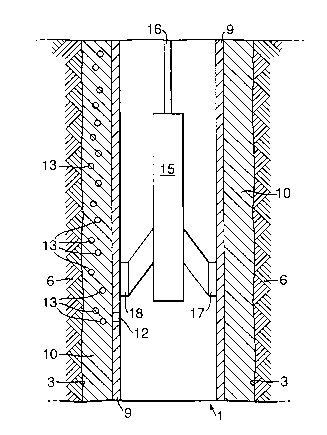Some of the information on this Web page has been provided by external sources. The Government of Canada is not responsible for the accuracy, reliability or currency of the information supplied by external sources. Users wishing to rely upon this information should consult directly with the source of the information. Content provided by external sources is not subject to official languages, privacy and accessibility requirements.
Any discrepancies in the text and image of the Claims and Abstract are due to differing posting times. Text of the Claims and Abstract are posted:
| (12) Patent Application: | (11) CA 2392064 |
|---|---|
| (54) English Title: | LEAK DETECTION METHOD |
| (54) French Title: | PROCEDE DE DETECTION DE FUITE |
| Status: | Deemed Abandoned and Beyond the Period of Reinstatement - Pending Response to Notice of Disregarded Communication |
| (51) International Patent Classification (IPC): |
|
|---|---|
| (72) Inventors : |
|
| (73) Owners : |
|
| (71) Applicants : |
|
| (74) Agent: | SMART & BIGGAR LP |
| (74) Associate agent: | |
| (45) Issued: | |
| (86) PCT Filing Date: | 2000-11-29 |
| (87) Open to Public Inspection: | 2001-06-07 |
| Availability of licence: | N/A |
| Dedicated to the Public: | N/A |
| (25) Language of filing: | English |
| Patent Cooperation Treaty (PCT): | Yes |
|---|---|
| (86) PCT Filing Number: | PCT/EP2000/012032 |
| (87) International Publication Number: | WO 2001040627 |
| (85) National Entry: | 2002-05-17 |
| (30) Application Priority Data: | ||||||
|---|---|---|---|---|---|---|
|
The method comprises the steps of: a) passing a sonic tool (15) provided with
a transducer package (17, 18) capable of sending and receiving a sonic signal,
through the well tubular; b) prior to start of hydrocarbon fluid production
through the well, inducing the transducer package (17, 18) to transmit the
sonic signal through the well tubular (9) and to receive a reflected signal,
and making a primary registration of the reflected signal indicative of a leak-
free well tubular; c) after start of hydrocarbon fluid production through the
well, inducing the transducer package (17, 18) to transmit the sonic signal
through the well tubular (9) and to receive a reflected signal, and making a
secondary registration of the reflected signal indicative of an operational
well tubular; d) comparing the primary and secondary registrations and
detecting a leak in the well tubular from a difference between said
registrations.
Le procédé comprend les étapes suivantes: a) passage dans la colonne d'un outil (15) acoustique équipé d'un transducteur (17, 18) capable d'émettre et de recevoir un signal acoustique; b) avant le début de la production de flux fluides d'hydrocarbures dans le puits, préparation de l'ensemble /17, 18) transducteur à l'émission du signal acoustique dans la colonne (9) et à la réception du signal réfléchi, et premier enregistrement du signal réfléchi indiquant l'absence de toute fuite dans la colonne; c) après le début de ladite production dans le puits, préparation de l'ensemble (17, 18) transducteur à l'émission du signal acoustique dans la colonne (9) et à la réception du signal réfléchi, et second enregistrement du signal réfléchi indiquant l'état opérationnel de la colonne; d) comparaison entre les premier et second enregistrements et détection d'une fuite dans la colonne à partir de la comparaison.
Note: Claims are shown in the official language in which they were submitted.
Note: Descriptions are shown in the official language in which they were submitted.

2024-08-01:As part of the Next Generation Patents (NGP) transition, the Canadian Patents Database (CPD) now contains a more detailed Event History, which replicates the Event Log of our new back-office solution.
Please note that "Inactive:" events refers to events no longer in use in our new back-office solution.
For a clearer understanding of the status of the application/patent presented on this page, the site Disclaimer , as well as the definitions for Patent , Event History , Maintenance Fee and Payment History should be consulted.
| Description | Date |
|---|---|
| Inactive: IPC deactivated | 2016-03-12 |
| Inactive: First IPC assigned | 2016-01-29 |
| Inactive: IPC assigned | 2016-01-29 |
| Inactive: IPC expired | 2012-01-01 |
| Time Limit for Reversal Expired | 2005-11-29 |
| Application Not Reinstated by Deadline | 2005-11-29 |
| Deemed Abandoned - Failure to Respond to Maintenance Fee Notice | 2004-11-29 |
| Inactive: Cover page published | 2002-10-25 |
| Inactive: Notice - National entry - No RFE | 2002-10-23 |
| Letter Sent | 2002-10-23 |
| Inactive: Applicant deleted | 2002-10-23 |
| Application Received - PCT | 2002-08-19 |
| National Entry Requirements Determined Compliant | 2002-05-17 |
| Application Published (Open to Public Inspection) | 2001-06-07 |
| Abandonment Date | Reason | Reinstatement Date |
|---|---|---|
| 2004-11-29 |
The last payment was received on 2003-09-05
Note : If the full payment has not been received on or before the date indicated, a further fee may be required which may be one of the following
Please refer to the CIPO Patent Fees web page to see all current fee amounts.
| Fee Type | Anniversary Year | Due Date | Paid Date |
|---|---|---|---|
| Basic national fee - standard | 2002-05-17 | ||
| Registration of a document | 2002-05-17 | ||
| MF (application, 2nd anniv.) - standard | 02 | 2002-11-29 | 2002-10-03 |
| MF (application, 3rd anniv.) - standard | 03 | 2003-12-01 | 2003-09-05 |
Note: Records showing the ownership history in alphabetical order.
| Current Owners on Record |
|---|
| SHELL CANADA LIMITED |
| Past Owners on Record |
|---|
| WILHELMUS HUBERTUS PAULUS MARIA HEIJNEN |